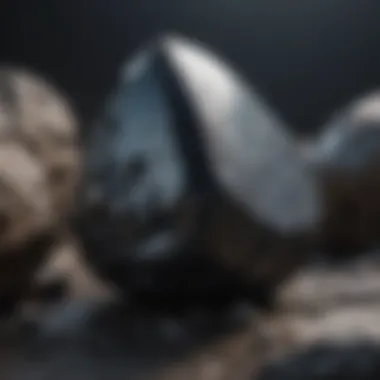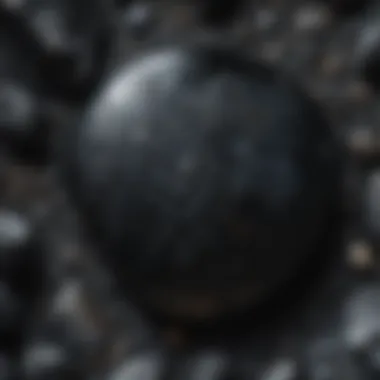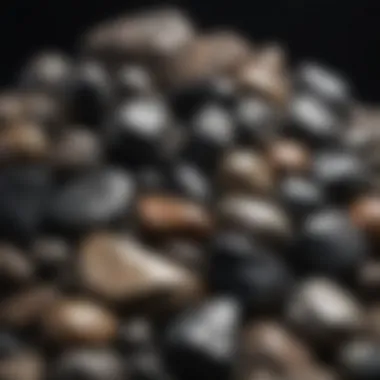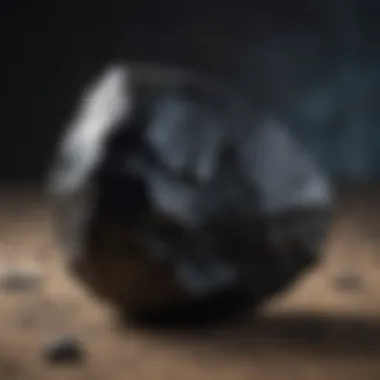Unearthing the Value of Large Obsidian Rocks


Intro
The allure of large obsidian rocks is undeniable, attracting collectors and enthusiasts alike. These natural treasures, formed from volcanic eruptions, are more than just striking pieces of stone; they’re windows into Earth’s transformative processes and human history. As we embark on this exploration, we’ll dissect the various facets of obsidian, from its characteristics and formation to its cultural significance and applications.
Obsidian is the product of rapid cooling of volcanic lava, leading to a glassy texture that is both beautiful and functional. With an extensive range of colors from rich blacks to browns, greens, and even translucent tones, each piece holds a story, often dating back centuries. The unique properties of obsidian make it not just a collectible item, but also a subject rich with geological and anthropological insights.
As we delve deeper, we'll navigate through its identification and classification, key considerations for potential buyers, and the broader cultural implications of this fascinating mineral.
Foreword to Obsidian
Obsidian is as captivating as it is complex, found where volcanic eruptions have left their mark on the landscape. This article dives into the richness of this beautiful rock, seeking to uncover both its secrets and its significance in various domains. From collectors who treasure geological specimens to artists who mold obsidian into intricate designs, understanding this material is paramount for anyone drawn to its allure.
Obsidian isn’t just a pretty face in the world of minerals; its unique characteristics make it an essential subject of study for geologists, collectors, and craftsmen alike. Known as volcanic glass, it forms when lava cools rapidly, allowing it to maintain a glassy surface that is often smooth and alluring to the touch. But there’s more than just beauty at play here; this fascinating mineral has a rich history and practical applications that stretch far beyond mere decoration.
Definition and Composition
Obsidian is defined simply as a naturally occurring volcanic glass. Its main component is silica, which is present in significant quantities alongside minor amounts of other minerals. This unique combination gives obsidian its striking appearance—typically a deep black but often manifesting shades of brown, green, or even iridescent hues. This variation is primarily due to the presence of iron and magnesium within the rock.
Beyond its aesthetic qualities, the composition of obsidian plays a critical role in its uses. The structure of obsidian is amorphous, lacking a crystalline form, which is quite uncommon in the mineral world. This peculiarity not only contributes to its visual charm but also results in its intriguing physical properties, such as sharpness when fractured—making it historically significant as a material for tools and weapons in ancient cultures.
Origin and Geological Formation
The origin of obsidian is intrinsically linked to volcanic activity. When magma rises from beneath the Earth’s crust and erupts at the surface, it can cool rapidly upon contact with air or water, forming obsidian instead of crystallizing into a more traditional rock. This process can vary wildly depending on factors such as the volcanic environment, temperature, and mineral composition of the lava itself. Such variability contributes to the diverse range of obsidian types found across the globe.
One notable geological location for large obsidian formations is the Glass Mountain in California, where extensive deposits reveal a staggering amount of this exotic material. Similarly, obsidian is also found around the world—in places like East Africa, Iceland, and the Andes, each site contributing its distinctive properties to the rocks it produces.
Characteristics of Large Obsidian Rocks
Understanding the characteristics of large obsidian rocks is vital for collectors and enthusiasts alike. Each rock embodies a unique blend of physical properties, color variations, and natural formations that can significantly influence its desirability and value. Not only does this knowledge help in making informed purchasing decisions, but it also deepens appreciation for this striking volcanic glass.
Physical Properties
Large obsidian rocks possess distinctive physical traits that set them apart from other minerals. For many collectors, the most astonishing feature is their glassy luster, a result of rapid cooling of molten lava. This cooling process prevents crystallization, leading to an almost mirror-like surface. The hardness of obsidian ranks about 5 to 5.5 on the Mohs scale, meaning it can scratch most materials, but it's also brittle. This duality can be a double-edged sword—while it’s strong enough for various applications, one should handle it with care to avoid chipping.
Moreover, the sharp edges formed during natural fracturing have historically been used for tools and weapons, a testament to the rock's utility. Just imagine, flakes of obsidian would have served our ancestors as knives or arrowheads—real history laid bare in layers of stone.
Color Varieties and Patterns
Diving deeper into the obsidian spectrum, it's clear that color plays a substantial role in desirability. While most are black, shades range from vibrant greens and browns to translucent versions. For instance, Mahogany obsidian exhibits reddish-brown swirls, while Snowflake obsidian features white splotches that resemble delicate snowflakes. Such diversity not only makes each specimen visually captivating but also subject to artistic interpretation. Collectors often gravitate toward specific patterns, with some preferring the darker types for their elegance, while others lean toward those with intricate designs.
"In every piece of obsidian, there’s a story waiting to be told through its colors and formations."
Formation of Natural Shapes
The natural formations found in large obsidian rocks can be as much a conversation starter as they are a point of interest in collections. Factors like the cooling rate and the volcanic activity of the region influence these shapes. You might encounter spherical pieces called ‘obsidian spheres,’ which are polished to a high shine, or ‘obsidian arrowheads,’ which showcase the sharpness and historical craftsmanship of ancient artisans.
Natural formations arise from the unique interaction of lava with water or air. For example, if an obsidian flow encounters water, it can create fascinating textured surfaces. Collectors should seek out these uniquely shaped specimens as they add character to any collection. Knowing how these shapes developed can enrich the collector's narrative, placing them in the context of nature’s artistry.
The charm of large obsidian rocks is not just in their looks, but in the complexity of their properties. Grasping these characteristics allows collectors to appreciate their value not just as geological specimens but as timeless pieces of art and history.


Market Overview for Large Obsidian Rocks
In today's world, large obsidian rocks are not just geological curiosities; they are increasingly becoming coveted collectibles. Understanding the market landscape helps enthusiasts and collectors grasp both the potential investments and the rich history tied to these unique geological artifacts. This section will explore current trends in collectibles and the various pricing factors that influence large obsidian rocks in the market.
Trends in Collectibles
Over the past few years, the fascination with natural gemstones and geological specimens has surged. Collectors are drawn to obsidian due to its striking appearance and its diverse uses. Some of the trends noticeable in the market include:
- Increased Online Presence: With platforms like Facebook and Reddit serving as meeting grounds, collectors share their finds, tips, and even trade. Online auctions and trading have also gained traction, boosting visibility for sellers.
- Artistic Use: Artists and craftsmen have started repurposing large obsidian rocks into sculptures and decorative pieces. This has opened new avenues for both appreciation and pricing.
- Sustainability Concern: A growing concern for the environment means that many buyers are now leaning towards sustainably sourced obsidian. This leads to a preference for rocks that are ethically harvested from known geological locations, ensuring minimal environmental impact.
These trends reflect a broader appreciation for not just the physical beauty of obsidian, but its cultural and historical significance, cementing its status as a notable addition in the collectibles market.
Pricing Factors
Several factors play into the pricing of large obsidian rocks, pointing to both market demand and the unique characteristics of the stone itself. Here is a closer look:
- Size and Weight: Larger specimens tend to fetch higher prices. A sizable rock that can serve as a focal point in a collection or display will naturally have more appeal.
- Quality and Finish: The polish and overall quality of the obsidian are crucial. Rocks that exhibit a high-quality sheen and lack blemishes command a premium.
- Rarity: Not all obsidian is created equal. Variants such as snowflake obsidian or rainbow obsidian, with their unique patterns and colors, can significantly increase value due to their rarity.
- Origin: The geological location where the obsidian was sourced can affect its desirability and price. For example, obsidian from respected localities often carry provenance, making them more sought after.
"The market dynamics of large obsidian rocks underscore not just their beauty but the complex interplay of rarity, quality, and cultural relevance that binds collectors to these natural treasures."
In summary, the market for large obsidian rocks is vibrant and multifaceted. Collectors need to remain informed of prevailing trends and factors influencing pricing to make educated purchasing decisions.
Where to Find Large Obsidian Rocks for Sale
Finding large obsidian rocks for sale involves more than just a cursory online search. It’s a journey into the heart of geology, an exploration of ancient volcanic activity, and discovering the perfect piece for your collection. Recognizing the most fruitful sources not only saves time but also enhances the chance of acquiring high-quality specimens. This section will guide you through key geological locations, renowned online marketplaces, and local events where collectors can uncover exceptional obsidian pieces.
Geological Locations of Interest
When talking about geological locations, certain regions stand out due to their rich volcanic history. Rocks formed from ancient lava flows tend to yield some of the most visually stunning obsidian specimens.
- United States: The western part of the country is particularly rich in obsidian. Notable areas include the Mojave Desert in California, which features vast stretches of obsidian deposits, and Newberry Volcanic National Monument in Oregon, where major flows of obsidian can be found.
- Mexico: This country is renowned for its obsidian sources, particularly around Zacatecas and Puebla. The obsidian from Mexico often showcases beautiful colors and patterns, making them highly sought after.
- Iceland: Known for its dramatic landscapes, Iceland offers an impressive display of obsidian, especially in regions with recent volcanic activity.
Understanding these locations may guide collectors in forming a plan to scout potential finds, whether they visit or seek to source from there.
Online Marketplaces
The digital age has brought many benefits for collectors seeking obsidian. Online marketplaces can serve as treasure troves for those in search of large obsidian rocks. Here’s a look at some prominent options:
- Etsy: This platform has a plethora of artisans and sellers specializing in minerals and gemstones. A quick search can lead to unique obsidian pieces that reflect creativity and craftsmanship.
- eBay: A giant in online auctions, eBay allows users to find rare obsidian specimens, often at competitive prices. Pay attention to seller ratings and descriptions to gauge authenticity.
- Facebook Groups: Joining dedicated rock and mineral groups on Facebook can open doors to community members who sell or trade obsidian. This can also lead to opportunities for learning more about the material and connecting with fellow enthusiasts.
Online shopping does come with its own set of challenges, particularly surrounding authenticity. Therefore, it's crucial to thoroughly review sellers and their raw materials.
Local Rock and Mineral Shows
Nothing beats the thrill of visiting local shows. Rock and mineral shows present a rare opportunity to physically inspect obsidian specimens. Sharing experiences with fellow collectors and discussing pieces with sellers adds layers to the collecting process. Here’s what to keep in mind:
- Networking: Engaging with other collectors can yield insights not just about obsidian, but also lead you to excellent sources.
- Direct Inspection: Seeing a piece in person allows you to better assess its quality and suitability for your collection.
- Education: Many shows offer seminars and talks that can deepen your understanding of obsidian and its significance in the world of collectibles.
Whether it’s browsing stalls, chatting with experts, or simply observing how others appreciate large obsidian rocks, these events bring together enthusiasts in celebration of natural beauty.


Exploring geological locations, engaging in online marketplaces, and immersing yourself in local shows is key to finding large obsidian rocks. The journey, much like the obsidian itself, can be filled with surprises.
Considerations Before Purchasing
When it comes to large obsidian rocks, there’s a lot more than what meets the eye. Collecting these unique volcanic pieces can be quite the endeavor, and taking a closer look at what to think about before making a purchase helps ensure you land a gem rather than a dud. Here we delve into some crucial aspects that every potential buyer should keep in mind, enhancing the overall experience of acquiring such remarkable specimens.
Authenticity and Verification
Imagine this: you’ve found a stunning large obsidian rock, maybe with a rich color or striking pattern, but how do you know it’s the real deal? Authenticity is non-negotiable for collectors who want to ensure they’re investing in genuine obsidian rather than some clever imitation. It’s kinda like finding that perfect pair of jeans—you wanna make sure that label is legit.
To verify authenticity, consider the following steps:
- Request Documentation: Ask the seller for certificates or provenance that demonstrate the rock’s origin. Authentic dealers often provide this.
- Check for Knapping: Look for signs of knapping. Genuine obsidian often has sharp edges, a characteristic that can help distinguish it from fakes.
- Engage with Experts: Don’t hesitate to bring in a geologist or a collector with experience. Their insight can be invaluable, providing reassurance before you hand over any cash.
In a nutshell, having confidence in the provenance of your rock calms the nerves and solidifies its value in your collection.
Grading and Classification
Grading is integral to understanding the quality and worth of a large obsidian rock. It’s akin to appraising art—certain features can boost the appeal and price of these natural artifacts. Differentiating between types and qualities lays the groundwork for a fruitful investment.
Obsidian can be classified based on:
- Color: From deep black to rich greens, reds, or even shimmering golds, color plays a key role in grading. Unique color combinations often fetch higher prices.
- Transparency: Some obsidian is opaque while others may be translucent. The level of transparency can significantly influence valuation.
- Inclusions: Look out for any natural inclusions or patterns inside the stone. These characteristics can add a unique flair and increase desirability.
Understanding how to navigate this grading can give buyers a clearer picture of what they are purchasing, leading to more informed decisions.
Condition and Care Requirements
Buying obsidian, especially large pieces, is one thing, but caring for them is another ball game. These rocks can be relatively hardy, but they ain't indestructible—knowing how to protect and maintain your new acquisition will surely extend its life and luster.
Here are some care tips:
- Avoid Moisture: While not overly sensitive, excessive exposure to water can tarnish the beauty of obsidian. Try to keep it dry and dust-free—think of it as enjoying a day at the beach, but keeping the sand out of your shoes.
- Handle with Care: Treat these pieces as you would a delicate sculpture. Direct impacts can chip and even crack the stone.
- Display: Choose a stable, secure place away from direct sunlight to showcase your rock. Prolonged exposure can lead to fading of colors.
In sum, being knowledgeable about how to maintain the condition of large obsidian rocks not only safeguards your investment but also fosters a deeper appreciation for these stunning geological creations.
"The beauty of natural obsidian lies not just in its form, but in understanding the journey of where it came from and how best to honor it."
Through careful consideration of these factors, potential buyers are better equipped to navigate the waters of purchasing large obsidian rocks— ultimately ensuring that their investment is both meaningful and wise.
The Cultural Significance of Obsidian
Obsidian is not just a striking mineral; it is woven into the very fabric of numerous cultures throughout history. This volcanic glass has captured human imagination and serves multiple purposes, from practical tools to symbolic representations. Understanding the cultural significance of obsidian provides deeper insight into not only the mineral itself but also the societies that have revered it.
Historical Uses in Tools and Artifacts
From ancient times, obsidian was highly prized for its sharpness and durability. Various cultures relied on it to craft tools and weapons. The Aztecs, for example, skillfully shaped obsidian into arrowheads and blades, showcasing both practicality and artistry. Each chipped edge not only represented a tool for survival in a harsh environment but also an expression of the artisan’s skills and cultural identity.
In prehistoric contexts, archeological evidence points to the extensive use of obsidian in the Near East and Mediterranean regions. Some artifacts have been dated back to the Stone Age, essentially testifying to its significance in human development. Researchers believe obsidian was preferred due to its ability to yield a sharp edge, which was far superior to many other natural materials.


- Practical Utility: Creating effective tools for hunting and defense.
- Artistic Expression: Making intricate ornaments and ceremonial items.
- Trade Good: Acting as a valuable commodity in ancient trade networks, facilitating interactions between diverse cultures.
Obsidian artifacts unearthed in various excavation sites reveal a lot about how ancient societies functioned and interacted. Their presence across different regions marks not just trade but also cultural exchange, suggesting an appreciation for the mineral that transcended boundaries.
Modern Applications in Art and Craft
In today’s context, obsidian continues to captivate artists and craftspeople alike. Many modern artisans employ large obsidian rocks to create sculptures, jewelry, and other artistic expressions. The glassy texture and sparkling surface of obsidian lend itself well to both decorative and functional pieces that resonate with a contemporary audience seeking unique art forms.
- Sculptural Works: Large obsidian rocks are transformed into stunning sculptures, sometimes reflecting themes of nature, spirituality, or even abstract concepts.
- Jewelry: Crafting stunning necklaces, earrings, and bracelets that blend modern aesthetics with ancient tradition.
- Functional Art: Creating knife handles or decorative home items that are both beautiful and practical.
Artisans today often look to ancient techniques while integrating new ideas, making obsidian a bridge between past and present. Additionally, certain pieces carry symbolic meanings, often resonating with personal stories or communal heritage. This connection to both history and personal expression elevates obsidian from mere material to a multidimensional art form.
Obsidian, whether as a tool of the past or the canvas of present-day creativity, underscores the enduring relationship between humankind and the natural world.
Obsidian in Various Cultures
The tale of obsidian stretches far beyond its geological formation and physical properties. Its significance permeates various cultures, painting a complex picture of its role within societies throughout history. Those who dive into the realm of obsidian will find it has woven itself into the very fabric of cultural narratives, customs, and practices across the globe.
Mythology and Symbolism
Obsidian has been cloaked in mystique and reverence in numerous mythologies. For many indigenous tribes in Mesoamerica, it was more than just a tool; it was a sacred stone. The Aztecs utilized obsidian to craft sharp tools and weapons, but they also revered it as a material connected to the underworld. For instance, they believed that its shiny black surface mirrored the night sky, connecting their world to the divine.
In some legends, obsidian is seen as a reflection of the heart—it can reveal one’s true intentions and emotions. Those who carry obsidian talismans often do so in the hope of protective energy, warding off negativity, and promoting a sense of grounding. This belief still resonates with those who engage in crystal healing, where obsidian is valued for its purported ability to absorb psychic stress and prevent harm.
"In every shard of obsidian lies a world undiscovered for those daring enough to confront their fears, to look within, and to emerge transformed."
Role in Ancient Civilizations
The contributions of obsidian to ancient civilizations cannot be overstated. Its sharp edges made it an invaluable resource for crafting tools. The Olmecs, often referred to as the mother culture of Mesoamerica, were among the first to utilize obsidian. They produced ceremonial blades and artifacts that served as a testament to their advanced craftsmanship.
Moreover, trade routes were established based on obsidian. The exchange of obsidian artifacts between regions, such as from the central highlands of Mexico to the Gulf coast, illustrates how valuable this resource was, not just for practical tools but also as a commodity of cultural exchange. Obsidian artifacts have been found at archaeological sites across North America, emphasizing its widespread importance.
In comparison to plethora of other materials, obsidian’s unique qualities made it easy to shape into specific forms—blades capable of performing surgical tasks even today, sharp enough to rival modern surgical instruments.
In summary, obsidian is more than a rock to be collected; it embodies a rich tapestry of cultural narratives and significance, resonating with history, mythology, and ancient craftsmanship. Understanding this dimension enhances one’s appreciation when collecting and studying large obsidian rocks—transcending mere aesthetics to embody stories of civilizations long past, and their enduring relationship with the earth.
Closure
As we draw curtains on the discussion surrounding large obsidian rocks for sale, it's crucial to reflect on the significance of this remarkable mineral. Obsidian, with its striking appearance and rich history, not only captivates collectors but also serves as an insightful mirror into our diverse cultures and their practices.
Summary of Key Points
In this article, we've traversed through several pivotal aspects of obsidian:
- Definition and Composition: We discussed its volcanic origin, highlighting how its glassy texture is derived from rapid cooling of lava.
- Characteristics: The physical properties and varied colors of obsidian showcase why it's a sought-after piece for collectors.
- Market Overview: Insights into current market trends and the pricing factors surrounding large obsidian rocks are vital for potential buyers looking to make sound investments.
- Purchase Considerations: Authenticity checks, meticulous grading, and understanding care instructions are essential steps in the purchasing process.
- Cultural Significance: From ancient tools to artistic applications today, obsidian's influence stretches through ages, revealing how humans have interacted with this material.
Celebrating these facets empowers collectors, whether seasoned or new, to appreciate their obsidian pieces not just as rocks but as artifacts of our shared heritage.
Future of Collecting Obsidian
The trajectory of collecting obsidian looks promising, especially as enthusiasts become more aware of its potential. Here are some points that shed light on what may lie ahead:
- Emergence of New Varieties: With ongoing geological processes, the discovery of new obsidian types may introduce more unique collectibles to the market.
- Sustainable Practices: Ethical sourcing will likely be a focal point for collectors moving forward, emphasizing sustainability while acquiring these rocks.
- Community Growth: As the interest in geological specimens continues to burgeon, communities around obsidian collecting are poised to strengthen. Online platforms and local shows will foster deeper connections amongst collectors, leading to shared knowledge.
In sum, large obsidian rocks are much more than natural artifacts; their narratives weave through time and culture. For those who seek to delve into this world, understanding both the scientific and cultural background enhances every aspect of collecting. Embrace the intricacies of obsidian, for they present a unique opportunity to connect the past with the present. This is not just about the rocks; it’s about the stories they tell and the history they hold.



